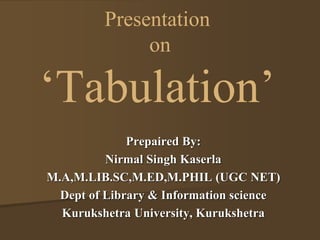
Tabulation
- 1. Presentation on ‘Tabulation’ Prepaired By: Nirmal Singh Kaserla M.A,M.LIB.SC,M.ED,M.PHIL (UGC NET) Dept of Library & Information science Kurukshetra University, Kurukshetra
- 2. “Tabulation”
- 3. INTRODUCTION The classification of data leads to the problem of presentation of data. The presentation of data means exhibition of the data in such a clear and attractive manner that these are easily understood and analyzed. There many forms of presentation of data of which the following three are well known: (i). Textual Presentation, (ii). Tabular Presentation, (iii). Diagrammatic Presentation. Here, we discuses in detail Tabular method of data presentation.
- 4. What is a Table: A table is a symmetric arrangement of statistical data in rows and columns.
- 5. DEFINITIONS “Table involves the orderly and systematic presentation of numerical data in a form designed to elucidate the problem under consideration.” ---According Prof. L.R.Connor,” “Table in its broadest sense is an orderly arrangement of data in column and rows. “ ---According to Prof. M.M. Blaire
- 6. MEANING In the light of above mentioned definitions we can say in brief, “Table is systematic organization and presentation of data in the form of rows and columns. Whereas rows are horizontal arrangements and columns are vertical arrangements.
- 7. Features of a good Table Title as compatible with the objective of the study To facilitate comparison. Ideal Size Stubs Use of Zero Heading cont…
- 8. Abbreviation Footnote Total Source of data Size of Columns Simple, Economical and Attractive
- 9. Objectives of Tabulation To carry out investigation To do comparison To locate omissions and errors in the data. To use space economically To simplify data To use it as future reference
- 10. Parts of a Table Table number Title of the table Caption and stubs Body Prefatory or head note Footnotes
- 11. Table Number and Title [Head or Prefatory Note (if any)] Subheading Caption Total(Rows) Subhead Subhead Column-head Column-head Column-head Sub Entries Total (column) Footnote : Source Note : Parts of a Table
- 12. Types of Tables There are three basis of classifying tables. I. Purpose of a table II. Originality of a table III. Construction of a table.
- 13. Kinds of Tables According to Purpose According to Originality According to Construction General Purpose Table Special Purpose Table Original Table Derived Table Simple or One-Way Table Complex Table Double or Two-Way Table Treble Table Manifold Table
- 14. I. According to Purpose General Purpose Table: General purpose table is that table which is of general use. It is does not serve any specific purpose or specific problem under consideration. Special Purpose Table: Special Purpose table is that table which is prepared with some specific purpose in mind.
- 15. II. According to Originality Original Table: An original table is that in which data are presented in the same form and manner in which they are collected. Derived Table: A derived table is that in which data are not presented in the form or manner in which these are collected. Instead the data are first converted into ratios or percentage and then presented.
- 16. III. According to Construction Simple Table Complex Tables a. Double or Two-Way Table b. Three-Way Table c. Manifold (or Higher Order) Table
- 17. Simple Table In a simple table (also known as one-way table), data are presented based on only one characteristic. Table 1.1 illustrates the concept.
- 18. Table 1.1 Faculty-wise Library Users Faculties Number of Users Science 50 Commerce 70 Arts 90 Total 210
- 19. Complex Tables In a complex table (also known as a manifold table) data are presented according to two or more characteristics simultaneously. The complex tables are two-way or three-way tables according to whether two or three characteristics are presented simultaneously. a. Double or Two-Way Table b. Three-Way Table c. Manifold (or Higher Order) Table
- 20. Double or Two-Way Table In such a table, the variable under study is further subdivided into two groups according to two inter-related characteristics. The two-way table is shown in Table 1.2.
- 21. Table 1.2 Faculty-wise Library Users Faculties Numbers of User Girls Boys Total Science 20 30 50 Commerce 30 40 70 Arts 35 55 90 Total 85 125 210
- 22. Three-Way Table In such a table, the variable under study is divided according to three interrelated characteristics. The Three- Way Table is shown in Table 1.3.
- 23. Faculties Table 1.3 Faculty-wise Library Users Numbers of User Total (1)+(2) Girls Boys I Sem II Sem Total (1) I Sem II Sem Total (2) Science 15 20 35 20 30 50 85 Commerce 35 30 65 45 40 85 150 Arts 25 35 60 35 55 90 150 Total 75 85 160 100 125 225 385
- 24. Manifold (or Higher Order) Table Such tables provide information about a large no of interrelated characteristics in the data set. Manifold (or Higher Order) Table is shown in Table 1.4.
- 25. Faculties Table 1.4 Faculty-wise Library Users Numbers of User Total (1)+(2) B.A Ist B.A IInd Boys Girls Boys Girls I Sem II Sem I Sem II Sem Total (1) I Sem II Sem I Sem II Sem Total (2) Science 15 34 20 54 123 20 45 30 27 122 245 Commerc e 35 23 30 34 122 45 37 40 29 151 273 Arts 25 56 35 22 138 35 34 55 36 160 298
- 26. CONCLUSION With the help of above discussion we can say that table are help us to represent the data in the form of rows and columns and make it useful for the purposes.
- 27. Thank You